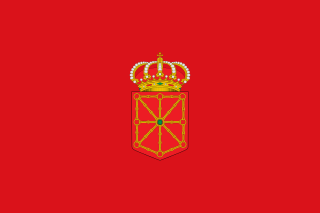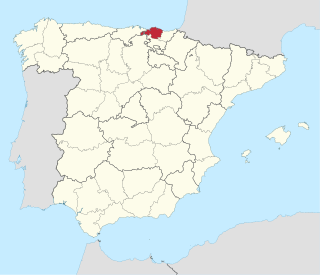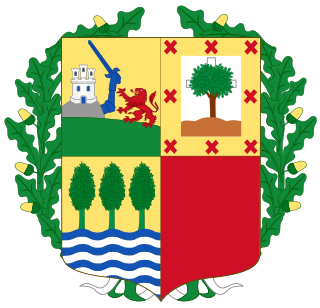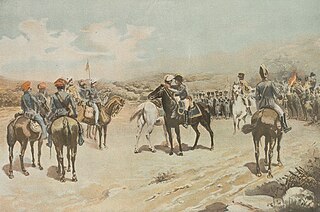
Navarre, officially the Chartered Community of Navarre, is a landlocked foral autonomous community and province in northern Spain, bordering the Basque Autonomous Community, La Rioja, and Aragon in Spain and Nouvelle-Aquitaine in France. The capital city is Pamplona. The present-day province makes up the majority of the territory of the medieval Kingdom of Navarre, a long-standing Pyrenean kingdom that occupied lands on both sides of the western Pyrenees, with its northernmost part, Lower Navarre, located in the southwest corner of France.

Biscay or Bizkaia, is a province of the Basque Autonomous Community, heir of the ancient Lordship of Biscay, lying on the south shore of the eponymous bay. The capital and largest city is Bilbao.

Basque nationalism is a form of nationalism that asserts that Basques, an ethnic group indigenous to the western Pyrenees, are a nation and promotes the political unity of the Basques, today scattered between Spain and France. Since its inception in the late 19th century, Basque nationalism has included Basque independence movements.

The Basque Nationalist Party, officially Basque National Party in English, is a Basque nationalist and regionalist political party. The party is located in the centre of the political spectrum.

The Kingdom of Navarre, originally the Kingdom of Pamplona occupied lands on both sides of the western Pyrenees, with its northernmost areas originally reaching the Atlantic Ocean, between present-day Spain and France.

Fuero, Fur, Foro or Foru is a Spanish legal term and concept. The word comes from Latin forum, an open space used as a market, tribunal and meeting place. The same Latin root is the origin of the French terms for and foire, and the Portuguese terms foro and foral; all of these words have related, but somewhat different meanings.

The First Carlist War was a civil war in Spain from 1833 to 1840, the first of three Carlist Wars. It was fought between two factions over the succession to the throne and the nature of the Spanish monarchy: the conservative and devolutionist supporters of the late king's brother, Carlos de Borbón, became known as Carlists (carlistas), while the progressive and centralist supporters of the regent, Maria Christina, acting for Isabella II of Spain, were called Liberals (liberales), cristinos or isabelinos. Aside from being a war of succession about the question who the rightful successor to King Ferdinand VII of Spain was, the Carlists' goal was the return to a traditional monarchy, while the Liberals sought to defend the constitutional monarchy.

The Third Carlist War, which occurred from 1872 to 1876, was the last Carlist War in Spain. It is sometimes referred to as the "Second Carlist War", as the earlier "Second" War (1847–1849) was smaller in scale and relatively trivial in political consequence.

The Statute of Autonomy of the Basque Country of 1979, widely known as the Statute of Gernika, is the legal document organizing the political system of the Autonomous Community of the Basque Country' which includes the historical territories of Alava, Biscay and Gipuzkoa. It forms the region into one of the autonomous communities envisioned in the Spanish Constitution of 1978. The Statute was named "Statute of Gernika" after the city of Gernika, where its final form was approved on 29 December 1978. It was ratified by referendum on 25 October 1979, despite the abstention of more than 40% of the electorate. The statute was accepted by the lower house of the Spanish Parliament on November 29 and the Spanish Senate on December 12.

The Convention of Vergara, entered into on 31 August 1839, was a treaty successfully ending the major fighting in Spain's First Carlist War. The treaty, also known by many other names including the Embrace of Vergara, was signed by Baldomero Espartero for the Isabelines and Rafael Maroto for the Carlists.

The Basques are an indigenous ethno-linguistic group mainly inhabiting the Basque Country. Their history is therefore interconnected with Spanish and French history and also with the history of many other past and present countries, particularly in Europe and the Americas, where a large number of their descendants keep attached to their roots, clustering around Basque clubs which are centers for Basque people.

The Southern Basque Country refers to the Basque territories southside of the Pyrenees, within the iberian peninsula.
The Economic Agreement is a juridical instrument that regulates the taxation and financial relations between the General Administration of the Kingdom of Spain and the Autonomous Community of the Basque Country.
The General Assemblies is the name of the legislative body (legislature) of the Spanish Basque territories of Biscay, Gipuzkoa, Alava and Navarre, and the elected assemblies to which the Government of each territory is responsible. The northern, French Basque Country, had its own regional assemblies until the Napoleonic period.
The constitution of Spain of 1978 allowed for the nationalities and regions that make up the Spanish nation to accede to self-government and be constituted as autonomous communities, which became the first-order political and territorial division of the Spanish territory. Both the process whereby the nationalities and regions were to accede to self-government and the scope of competences that were to be devolved or transferred from the central government, were intended to be asymmetrical in nature.

In the Spanish public discourse the territory traditionally inhabited by the Basques was assigned a variety of names across the centuries. Terms used might have been almost identical, with hardly noticeable difference in content and connotation, or they could have varied enormously, also when consciously used one against another. The names used demonstrate changing perceptions of the area and until today the nomenclature employed could be battleground between partisans of different options.
The Carlist Party of Euskal Herria, before 2000 known as the Carlist Party of Euskadi, is a left-wing Carlist Basque political party with presence in the Spanish Basque Country. The party was historically part of the pro-Carlos Hugo wing of the Carlist movement. The party was not legalized until late 1977.

Julián Elorza Aizpuru (1879-1964) was a Spanish Carlist politician. He is best known as advocate of Basque autonomous establishments, promoted during the Restoration, the Primo de Rivera dictatorship and the Second Republic. He was member of the provincial Gipuzkoan self-government and served as its president (1919-1924). Elorza was also the founder and the first president of Sociedad de Estudios Vascos (1919-1936). Politically he refrained from Carlist militancy and remained on conciliatory terms with most other political groupings.
The Gamazada is the popular reaction in Navarre in 1893 and 1894 to when the Spanish finance minister of the Liberal Party under Prime Minister Sagasta, Germán Gamazo, tried to suppress the fueros that had been established in the Compromise Act of 1841. It caused a huge uproar among the people and institutions of Navarre, with demonstrations and petitions.

Queen Isabella II of Spain was barely three years of age when her father, King Ferdinand VII, died on 29 September 1833. The years of her minority were marked first by the regency of her mother, Maria Christina of the Two Sicilies, and then under General Baldomero Espartero, covering almost the first ten years of her reign, until 23 July 1843, when Isabella was declared to be of age.

























